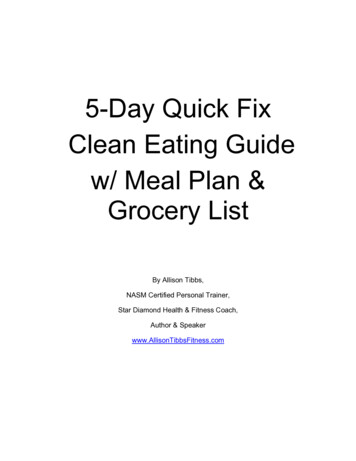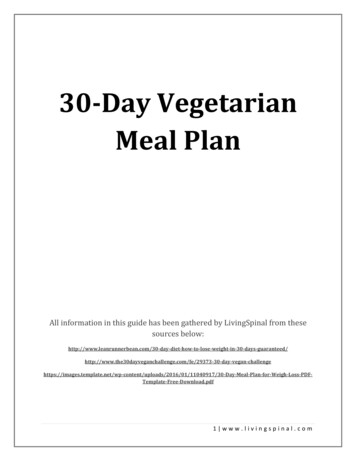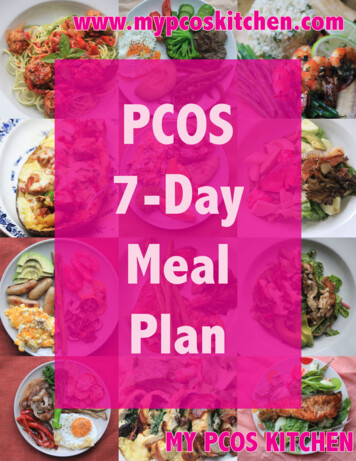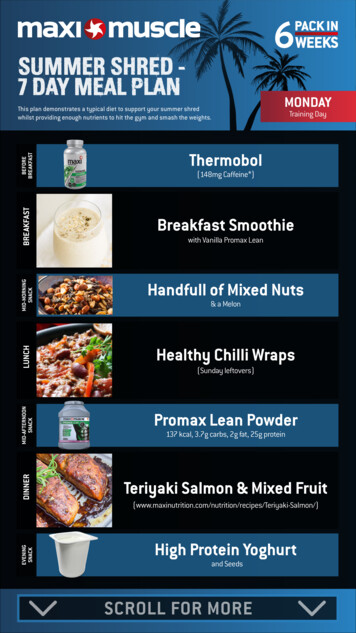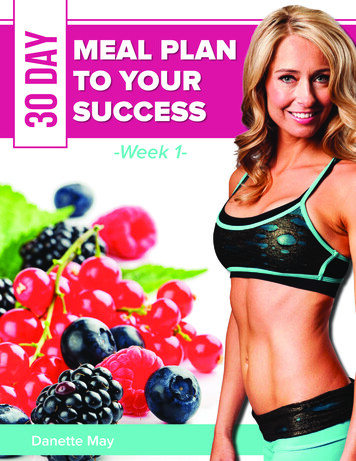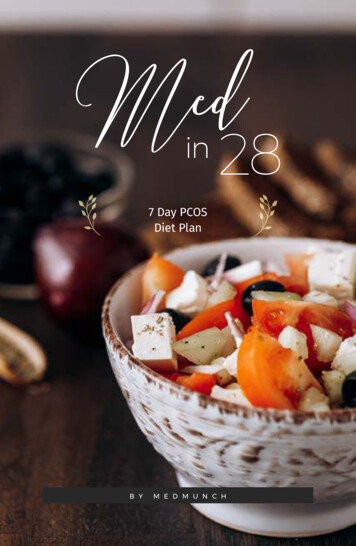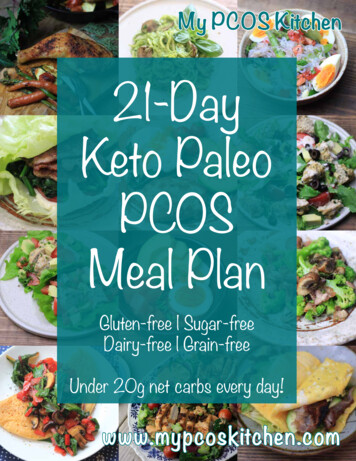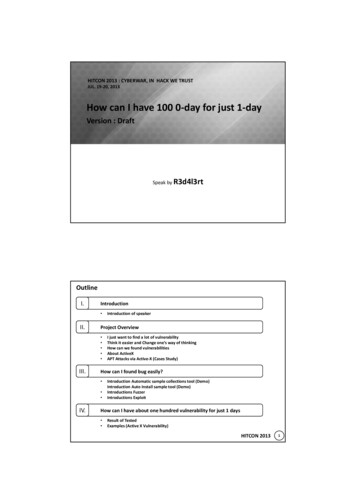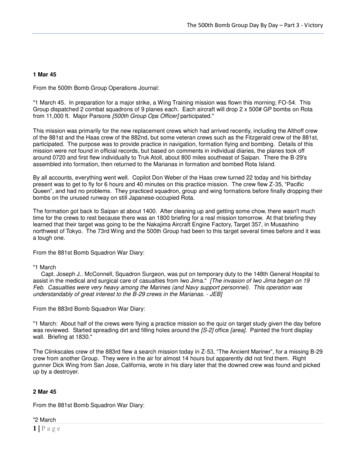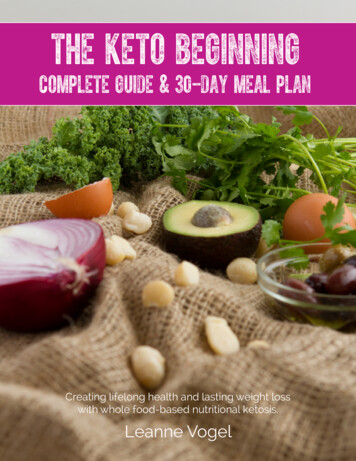
Transcription
HEALTHFULPURSUIT.COMthe keto beginningComplete Guide & 30-day Meal PlanCreating lifelong health and lasting weight losswith whole food-based nutritional ketosis.Leanne Vogel1
THE KETO BEGINNINGTHE KETO BEGINNINGComplete Guide & 30-day Meal PlanCreating lifelong health and lasting weight loss with whole food-basednutritional ketosis.Leanne VogelHealthful Pursuit Inc. is not a medical company or organization. Healthful Pursuit Inc. providesinformation in respect to healthy living, recipes, nutrition and diet and is intended for informationalpurposes only. Nothing contained in The Keto Beginning from Healthful Pursuit Inc. or its ownerneither is medical advice nor should be construed as medical advice. Healthful Pursuit Inc. encourages you to consult with your doctor before using The Keto Beginning. Any information generated, produced or disseminated by Healthful Pursuit Inc. should not and cannot be held as asubstitute for consultation, evaluation, or treatment by your doctor. Always seek the advice of yourdoctor or other qualified health provider with any questions you may have regarding a proposeddiet or nutrition program. Do not disregard professional medical advice or delay in seeking it because of something you have read in The Keto Beginning or on HealthfulPursuit.com.Copyright 2014 by Healthful Pursuit Inc.2
HEALTHFULPURSUIT.COMTABLE OF CONTENTSPrefaceChapter 1: It Begins HereChapter 2: My 30-Day ExperienceChapter 3: 9 Gems Of AdviceChapter 4: How I Found My MacrosChapter 5: Ode To FatsChapter 6: The Macro-Rana DanceChapter 7: What To Watch ForChapter 8: Power Supplements For Every DayChapter 9: Lessons On Low Blood PressureChapter 10: Testing, Testing, 1-2-3Chapter 11: Actions That Increase Decrease KetonesChapter 12: Workouts EnduranceChapter 13: Eating Schedules Intermittent FastingChapter 14: After The 30 Days Chapter 15: The Shopping ListsChapter 16: Meal PlansChapter 17: RecipesKeto FabulousLinks Studies3
THE KETO BEGINNINGPREFACEI’m in the best (hottest) shape of my life. The kind-of-hot that makes you want to pinch yourselfto validate if what you’re experiencing is actually real life. I don’t count calories, I dip my bacon inmayonnaise and snack on jars of almond butter with zero quilt.My body has found it’s happy place. Weight loss is effortless (I’ve lost 20lbs in 2 months), my skinis glowing, and I’m not a slave to pack-along snacks, cravings, or energy lulls anymore.The secret? Switching into a state of nutritional ketosis, where the body goes from burning glucose as energy to burning fat as energy. In nutritional ketosis, the body becomes a fat-burningmachine, effectively breaking down fatty acids into ketone bodies that are used, even by thebrain, as fuel. And we do this by following an eating style of high-fat, low-carb and moderate protein, also known as “keto” or “ketogenic”.While many keto-goers use dairy as their primary source of fats and rely on processed low-carbfoods to reduce their carb intake, The Keto Beginning proves that following a ketogenic eatingstyle can be done without the use of dairy or processed foods. In The Keto Beginning, we focuson benefiting the body, long-term, through paleo-friendly strategies, packed with whole foodsand rich nutrition.MY INTENTIONThis book is meant to highlight how easy and effortless living a dairy-free keto life can be.You may be thinking, but she has only been on this for 2 months, how could she possibly knowthat this lifestyle can be a lifelong ticket to lasting health? Great question.4
HEALTHFULPURSUIT.COMMy answer, in short, is because everything in The Keto Beginning acts to counteract the issuesthat get in the way of lifelong health. Blood sugar, especially.I’ve experienced more life-altering, positive changes with this next evolution in my eating stylethan I have with any other pattern. It’s the easiest, most effortless, most rewarding approach I’veever experimented with. A double bonus - the medical studies and research I’ve read points toblood sugar regulation through a high-fat, low-carb diet being the ticket to lasting health. I haveno doubt that the 2 months I’ve spent exploring this whole food-based ketogenic eating style hasbrought me closer to a life filled with endless happy, healthy days than any other approach I’vetried in the past. It’s an evolution.Coupled with my dairy-free, whole foods-loving approach, TheKeto Beginning satisfies all of the markers necessary for lifelonghealth - the natural reduction in calories, boosted saturated fats,blood sugar control, boosted cell health, ample mitochondriaaction, and more.I am not a scientist. I am a holistic nutritionist with an outrageous interest in self experimentation.I’ve listed medical studies, papers and resources in the back. After you’ve read a couple, I havea strong suspicion that (like me) you’ll begin to see the holes in the low-fat, high-carb approachwe’ve been led to believe is best for our health. The science just doesn’t add up! The Keto Beginning documents everything that I experienced in the first 30 days of getting into, and maintaininga state of nutritional ketosis. Because my body is different than your body, your experience willlikely be different than mine. And that’s cool.I hope this guide will act as a safe and healthy jumping off point for you.There aren’t a lot of “recipes” in the meal plan. Why? This is an introduction to nutritional ketosis. Ifound that; when I was first getting started, I had no idea what 75% fat, 10% carbs and 15% proteinlooked like on a plate, let alone what it felt like in my body.With 30 days of eating very simple meals, I built a strong base (a feeling and an eye) for what myeating pattern looked and felt like – on a plate, and in my body. Getting hung up with fancy recipes, make-ahead meal prep and the combination of oodles of ingredients makes it harder to fullyunderstand what exactly is going on in your body, and how you truly react to the meals you’reeating.If you’re looking for a ketogenic guide with endless recipes with combinations of ingredients thisway and that, this is not the book for you.If you are ready to make a lifestyle change by building a solid base of understanding so that youcan live your life with nutritional ketosis quietly running in the background, The Keto Beginning ishere to support your journey.You are ready. And I am here to guide you all the way through.5
THE KETO BEGINNINGIT BEGINS HEREChapter 1THE BASICSThough not mandatory (you can skip over this piece if you don’t care to know how this all works)understanding how the body functions, fully knowing what’s at play here, makes following theketogenic lifestyle more meaningful. At least, it does for me.To fully understand what’s going on here, we have to start from the very beginning. And the digestive system is the very best place to start.The Digestive ProcessWhen we consume food 1. The site of initial carbohydrate breakdown occurs in the mouth. Your teeth and tongue takethe first steps in battering food into bits. As they are shredding and grinding, more saliva issquirted into the food to moisten and soften it. The saliva contains chemicals called enzymes,which break down the carbohydrates in food (this enzyme release triggers insulin to startprepping for action).2. When you have finished chewing, you swallow, and the mouthful of food makes its waydown the esophagus, to the stomach. Food does not free fall down to the stomach but issqueezed along by the muscles in the esophagus. This squeezing/pushing action by the muscles is called peristalisis (perry-STAL-sis).3. The site of initial protein breakdown occurs in the stomach, where food is treated to a6
HEALTHFULPURSUIT.COMstrong acid bath as it’s churned around by the stomach’s muscular walls. These walls are protected by a mucus lining, which protects the stomach from its own gastric juices (made up ofpepsin enzyme and acids.)4. Up until now, carbohydrates have been broken down slightly in the mouth and proteinshave been broken down slightly in the stomach. Fats have not had their turn.5. Now, for the breakdown of fats and further breakdown of carbohydrates and proteins. Foodis now a mashed-up milky liquid, thanks to the stomach. It enters the duodenum (the beginning of the small intestine) where it is treated with a round of enzymes and bile to break thecarbohydrates, proteins and fats down even further.6. From there, the substance enters the small intestine - a 20-foot long, curly tube with ashaggy lining. The walls of the small intestines are lined with millions of tiny finger-like projections called villi. The villi absorb the usable parts of the broken down food into the bloodstream.7. The non-useful parts of the food continue to move into the large intestines. The large intestines absorb some of the water and salt. The remainder of the material is compacted and thensent out the anus as solid waste or feces.Carbohydrate DigestionCarbs are organic molecules that are made up of carbon, hydrogen and oxygen. There are threeprincipal carbohydrates present in foods 1. Simple Sugars (aka Simple Carbohydrates)2. Polysaccharides (aka Complex Carbohydrates)3. FiberSimple Sugars (aka simple carbohydrates) have 3 classifications, and several sub-segments below each class. It’s a web of sugary confusion! The most simplest of simple sugars are: glucose,fructose and galactose. These are called monosaccharides – this is how all sugars end up in ourbody when all is said and done.For instance, if you consume white sugar (sucrose) the body will break it down into glucose andfructose. If you consume a glass of milk (lactose) the body will break it down into galactose andglucose.Then there are oligosaccharides – simple sugars that consist of several sugars bound together.These unique carbohydrates cannot be easily digested by our regular digestive path and have togo to the large intestine to be eaten up by the bacteria there. Examples of oligosaccharide foodsare onions, asparagus, garlic, banana, and chives.Polysaccharides (aka complex carbohydrates) undergo substantial digestion before being absorbed. Starch is a polysaccharide – the main carbohydrate source for plant seeds and vegetables grown in the ground. Think potatoes, corn, rice, pasta, and cereal. Starches are broken downinto glucose by the body.7
THE KETO BEGINNINGAnother polysaccharide is cellulose, a carbohydrate that is indigestible in the body, adding bulk tothe stool.Fiber is another form of carbohydrate, one that is present in many polysaccharides. Fiber’s mainpurpose is to aid in elimination.The body converts digestible carbohydrates (the parts of the carbohydrate that are non-fiberous)into glucose, which our cells use as fuel. Some carbs (simple sugars, aka simple carbohydrates)break down quickly into glucose while others (polysaccharides aka complex carbohydrates) areslowly broken down and enter the bloodstream more gradually.The major takeaway here is that ALL dietary forms of carbohydrates are made up of sugar (glucose). Sweet potato, whitebread, whole grains, candy, potato chips, fruit, kale, all containcomponents that become sugar in the body.So that you fully “get the picture” on this carbohydrate thing, perhaps it would be helpful for me tolist some sources of carbohydrates, yes?Okay, here goes Bagels, bread, stuffing, buns, croutons, pancakes, English muffins, pita bread, tortillas, corn, waffles, wraps, beans, oatmeal, cornmeal, lentils, flour, hummus, rice, quinoa, pasta, peas, potatoes,squash, sweet potato, cow’s milk, rice milk, soy milk, yogurt, apples, cantaloupe, banana, apricots,dates, grapefruit, prunes, raspberries, watermelon, carrot juice, apple juice, tomato juice, cranberryjuice, kiwi, alcohol, biscuits, cookies, Danish, donuts, muffins, fruit pie, cupcakes, chocolate, potatochips, pretzels, crackers, sherbet, ice cream, tortilla chips, Jell-O, granola, cereal, French fries, apple butter, barbecue sauce, oats, cranberry sauce, salad dressing, ketchup, jams, jellies, candies,mints, gum, soda, gravy, honey mustard, dipping sauces, plum sauce, hollandaise sauce, maplesyrup, honey, agave nectar, coconut sugar, coconut nectar, noodles, lasagna, egg rolls, creamsoups, soups, chutney, arrowroot, tapioca, chickpea flour, sorghum, millet, amaranth, muesli,shredded wheat, popcorn, rice cakes, pudding, custard, almonds, cashews, pumpkin seeds, garbanzo beans, lima beans, green peas, carrots, pinto beans, navy beans, beets, onions, parsnips,bell peppers, spinach, greens, turnips, yams, white sugar, dates, date sugar, dried fruit, flour, pizza.The key here is that, regardless if you are consuming a simplecarbohydrate or complex carbohydrate, it will turn into “sugar” inthe body.8
HEALTHFULPURSUIT.COMINTRODUCTION TO A NEW WAYThe “Healthy” High-Carb ApproachOur current high-carbohydrate eating style of whole grains, oodles of servings of fruits and vegetables and minimal intake of fats has been touted as “healthy”. Now you know, from the previoussection that all forms of carbohydrate – fruits, vegetables, grains, sugars and anything starchy –are primarily broken down into glucose and stored in your body as glycogen.When you have more glycogen than what’s needed for immediate energy, your body will storeexcess in the liver, then the muscles and; if everything is full, the excess is converted into triglycerides and stored in your blood. Psst this is not a good thing.Relying on carbohydrates for fuel, is Not sustainable, we can only store a couple thousand calories of carbohydrates at any giventime. Preventing us from getting a handle on our blood sugar, causing endless cravings, oodles ofdaily eating times and weight gain. Leading to triglycerides being stored in the blood, the major risk factor to heart disease. . slowly killing us.In Nutritional Ketosis.Nutritional ketosis is a state where your body is “deprived” of glucose; achieved when carbohydrate intake is decreased and protein intake is moderated.
HEALTHFULPURSUIT.COM 1 Complete Guide & 30-day Meal Plan the keto beginning Creating lifelong health and lasting weight loss with whole food-based nutritional ketosis.
